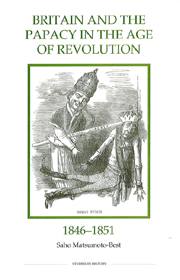Book contents
- Frontmatter
- Contents
- Dedication
- List of illustrations
- Acknowledgements
- Abbreviations
- Introduction
- 1 From 1815 to the election of Pius IX
- 2 The pope's liberal reforms, 1846–1847
- 3 The origins of the Minto mission
- 4 Britain and the 1848 revolution in Rome
- 5 Britain and the rise and fall of the Roman republic
- 6 The restoration of the Catholic hierarchy and anti-Catholicism in Britain
- Conclusion
- Bibliography
- Index
4 - Britain and the 1848 revolution in Rome
Published online by Cambridge University Press: 12 September 2012
- Frontmatter
- Contents
- Dedication
- List of illustrations
- Acknowledgements
- Abbreviations
- Introduction
- 1 From 1815 to the election of Pius IX
- 2 The pope's liberal reforms, 1846–1847
- 3 The origins of the Minto mission
- 4 Britain and the 1848 revolution in Rome
- 5 Britain and the rise and fall of the Roman republic
- 6 The restoration of the Catholic hierarchy and anti-Catholicism in Britain
- Conclusion
- Bibliography
- Index
Summary
By the end of 1847 British foreign policy towards the papacy had a number of clear aims: to encourage further liberal reforms, to counter Austrian influence and to win papal approval of Britain's policy towards Ireland. All of this was to be achieved by the mission of Lord Minto. However, despite her good intentions, Britain's timing was to prove disastrous, for in 1848 revolutions broke out over almost the whole of continental Europe. This upsurge in revolutionary activity naturally affected the nature of political debate in the Papal States, for the growing demands and strength of the radicals made it far more difficult for Pius to continue with his incremental reform policy. This was not the only difficulty caused by the wave of agitation. In addition the spread of revolution over virtually the whole of the peninsula sparked a surge in Italian nationalism and opposition to the Austrian presence in Italy. This, added to Austria's brutal attempt to suppress rebellion in its Italian possessions, led to calls for a crusade to evict the Habsburgs in which Piedmont played the leading role. The war issue was to cause grave difficulties for the pope, for it raised the question of whether Pius, as head of the Catholic Church as well as an Italian sovereign, could sanction a war against Austria.
The question that faced Britain was how to deal with this changing situation and how in these circumstances to achieve the goals laid down in the autumn of 1847.
- Type
- Chapter
- Information
- Britain and the Papacy in the Age of Revolution, 1846–1851 , pp. 71 - 110Publisher: Boydell & BrewerPrint publication year: 2003



